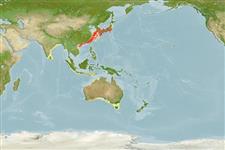Bivalvia |
Galeommatida |
Galeommatidae
Environment: milieu / climate zone / ระดับความลึก / distribution range
นิเวศวิทยา
; ระดับความลึก 0 - 100 m (อ้างอิง 3158), usually 5 - 50 m (อ้างอิง 75831). Tropical
Indo-West Pacific. Tropical to temperate.
Length at first maturity / ขนาด / Weight / Age
วัยเจริญพันธุ์: Lm ? range ? - ? cm Max length : 1.0 cm SHL เพศผู้/กระเทย; (อ้างอิง 3158)
Sand (Ref. 75831).
Life cycle and mating behavior
วัยเจริญพันธุ์ | การสืบพันธุ์ | การวางไข่ | Eggs | ความดกของไข่ | Larvae
Members of the class Bivalvia are mostly gonochoric, some are protandric hermaphrodites. Life cycle: Embryos develop into free-swimming trocophore larvae, succeeded by the bivalve veliger, resembling a miniature clam.
Lützen, J. and C. Nielsen 2005 Galeommatid bivalves from Phuket, Thailand. Zoological Journal of the Linnean Society 144:261-308. (อ้างอิง 3158)
IUCN Red List Status
(อ้างอิง 130435: Version 2025-1)
CITES status (อ้างอิง 108899)
Not Evaluated
CMS (อ้างอิง 116361)
Not Evaluated
Threat to humans
Human uses
| FishSource |
เครื่องมือ
ข้อมูลเพิ่มเติม
นิเวศวิทยาเขตร้อนFood items (preys)
องค์ประอบของอาหาร
การบริโภคอาหาร
ผู้ล่า
Population dynamicsการเจริญเติบโตMax. ages / sizesLength-weight rel.Length-length rel.Length-frequenciesMass conversionอุดมสมบรูณ์ Life cycleการสืบพันธุ์วัยเจริญพันธุ์ความดกของไข่การวางไข่EggsEgg developmentLarvae Human RelatedStamps, coins, misc.
แหล่งที่มาจากอินเตอร์เน็ต
Estimates based on models
Preferred temperature
(Ref.
115969): 18.2 - 26.5, mean 24.1 (based on 202 cells).
Fishing Vulnerability
Low vulnerability (10 of 100).
